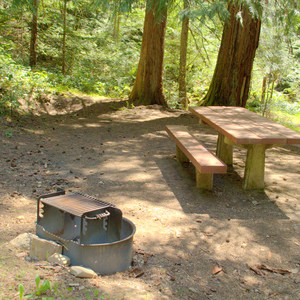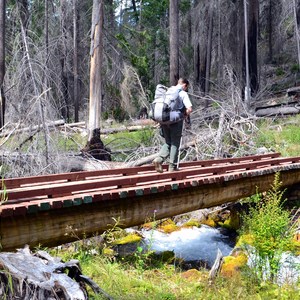You are here
Diamond Peak is named after John Diamond, who, with William Macy, made the first ascent of the shield volcano in July 1852 as part of a survey team, known as the Road Viewer, to plan a new road that would enable a crossing of the Cascades and lead directly to the upper Willamette Valley. The road would become known as the Free Emigrant Road due to the fact that no toll was required for its passage. An 1853 wagon train led by Elijah Elliot would use this new road to bring over 1,000 settlers over the pass, doubling the population of Lane County.
The trek begins by steeply climbing through old-growth forest littered with fallen trees and branches for 1.5 miles before reaching a trail junction. From here you will leave the trail, heading at 40 degrees northeast for a 0.75-mile bushwhack to find the southwest ridge. The ridge itself is not obvious until you have reached it. From here the route follows the ridge up to the false summit several hundred feet below Diamond Peak. A short traverse from the false summit follows a narrow ridge north to the true summit.
After taking in the summit view, there are several options for descent including skiing or snowboarding into the cirque or simply following the ridge back the way you came. If conditions allow, an epic 1,600-foot glissade can be had by dropping down into the western cirque, though this will take you down to the wrong side of the ridge that you followed on the way in. Care must be taken to cross back onto the ridge after the initial descent.
The technical difficulty of this climb depends greatly on the season. During winter the trailhead may be inaccessible by car due to snow, in which case one may snowshoe or ski in. During the spring, an ideal time for the climb, conditions may warrant snowshoes and/or crampons and ice ax. In later spring and early summer, one must be careful to watch for moats along boulder outcrops. The final traverse to the summit may have large cornices that should be avoided. In summer and fall the climb is mostly scrambling up boulder fields, but sun exposure can make it brutally hot, especially without the option for a quick descent.
Climbing Diamond Peak is a fantastic introduction to Oregon mountaineering within easy reach of Eugene and with multiple options for nearby camping, such as Secret Campground. While this climb is accessible to beginner mountaineers, this route does require route finding and is best explored with an experienced climber.










Comments
Sign In and share them.